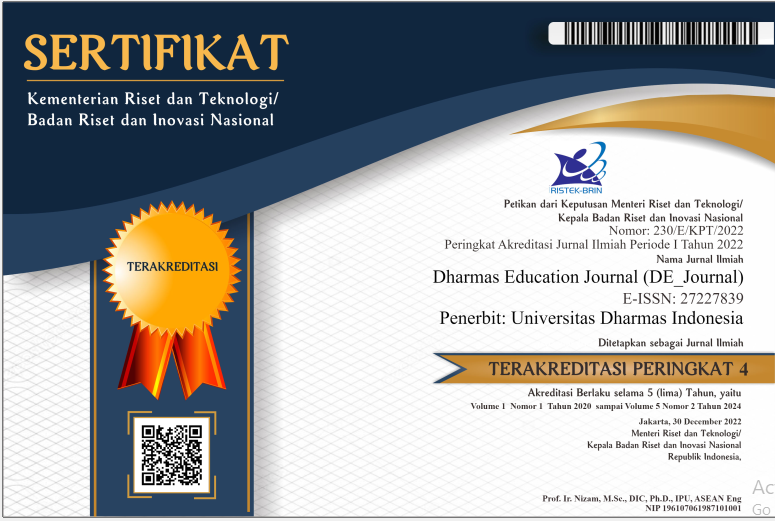AN ANALYSIS OF THE STUDENTS’ GRAMMAR DIFFICULTIES IN USING NOUN CLAUSE AT SECOND YEAR STUDENTS’ OF AKADEMI PARIWISATA JAKARTA
DOI:
https://doi.org/10.56667/dejournal.v2i1.245Abstract
Noun clauses are a component that needs to be learned in English. According to the 2004 curriculum or the Competency Based Curriculum (KBK) in English subjects, noun clauses are taught to University students in Semester IV, so this research was conducted to look at the difficulties of students in Semester IV using noun clause in reading and combining two sentences into one sentence. The form of this research is a study that describes a phenomenon that actually occurred in the field with a population of 60 students in Akademi Pariwisata Jakarta. So population taking, the authors use cluster random sampling to get valid and reliable tests, the authors carry out try out in classy classes. To try out the writer took data in Semester IV. The form of this research instrument is a written test. The test is in the form of multiple choice (multiple choice) consisting of 40 questions. These questions have been tested before, and then the questions were made into test questions for data collection after collecting data and deceiving data, the writer gets a percentage of students' ability scores in using Noun Clause 57.5% while students have difficulty using noun clause 42%, then students have difficulty using Noun Clause in learning English. Each category where the use of noun clauses. Which students get 41.48 who 42.14, whom 32.22, that 45.24, where 63.33 what 40.00 when 38.89 whose 41.67. Then the percentage of each category is generally greater than 40%, so the conclusion is that the Students of semester IV of Akademi Pariwisata Jakarta find the difficulty to use noun clauses caused by lack of facilities, vocabularies and motivation in studying English.
Downloads
References
Arshad, Z., Abdolrahimpour, M., & Najafi, M. R. (2015). The use of l1 as a consciousness-raising tool in teaching grammar to beginner and upper-intermediate efl students. Journal of Language Teaching and Research. https://doi.org/10.17507/jltr.0603.21
Bryman, A. (2015). Social Research Methods (4th Edition) by Alan Bryman. Abhigyan VO - 32.
Handayani, S., Youlia, L., Febriani, R. B., & Syafryadin, S. (2020). The Use Of Digital Literature In Teaching Reading Narrative Text. Journal of English Teaching, Applied Linguistics and Literatures (JETALL). https://doi.org/10.20527/jetall.v3i2.8445
Hodgson, J. (2020). How to teach grammar. English in Education. https://doi.org/10.1080/04250494.2020.1780827
Mills, G. E., & Gay, L. R. (2019). Educational Research: Competencies for analysis and application Twelfth Edition. In Educational Research.
Nanda, D. W., & Azmy, K. (2020). Poor Reading Comprehension Issue In Efl Classroom Among Indonesian Secondary School Students: Scrutinizing the causes, impacts and possible solutions. Englisia: Journal of Language, Education, and Humanities. https://doi.org/10.22373/ej.v8i1.6771
Nasution. (2009). Metode Research (Penelitian Ilmiah). In Metode Research (Penelitian Ilmiah).
Raipina. (2006). An analysis of Students Difficulties at Listening Irregular Verb in Simple Past Tense on the First year Students of SMK 2 Kosgoro Payakumbuh.
Sumampouw, H. M. (2015). Measurement An Evaluation In Teaching. Bioedukasi.
Zhang, G. (2020). A study of Grammar Analysis in English Teaching with Deep Learning Algorithm. International Journal of Emerging Technologies in Learning. https://doi.org/10.3991/ijet.v15i18.15425
Downloads
Published
How to Cite
Issue
Section
License
Copyright (c) 2021 DE_JOURNAL (Dharmas Education Journal)

This work is licensed under a Creative Commons Attribution-NonCommercial-NoDerivatives 4.0 International License.
Makalah yang disampaikan diasumsikan tidak mengandung bahan propietary yang tidak dilindungi oleh hak paten















